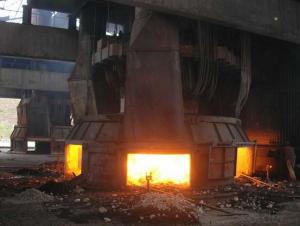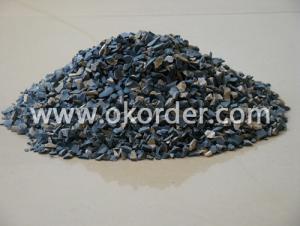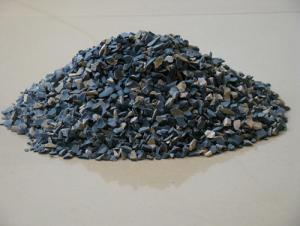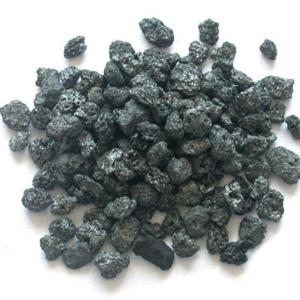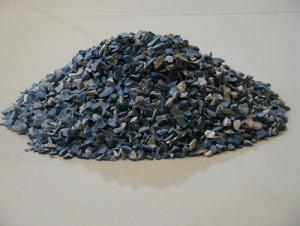Refractory Raw Materials-Silicon-Manganese Alloy
- Loading Port:
- Tianjin
- Payment Terms:
- TT OR LC
- Min Order Qty:
- 20 m.t.
- Supply Capability:
- 1000 m.t./month
OKorder Service Pledge
OKorder Financial Service
You Might Also Like
Main application of Silicon-manganese alloy
Silicon-manganese is a kind of alloy that consists of silicon, manganese, iron and few carbon or some other elements, it's a ferrous alloy which is used widely and high production capacity. Its consumption is in second of ferroalloy production. The manganese and silicon in silicon-manganese have strong oxygen affinity, using the silicon-manganese in smelting steel, will produce MnSiO3 and MnSiO4, their melting point are 12700C and 1327 0C respectively, which has the advantages of low melting point, big granule, easy to float up, good deoxidizing effect and so on.
In the same condition, using manganese or silicon to deoxidize separately, the burn out rate are 46% and 37%, but it is only 29% if using manganese alloy to deoxidize. So, it is used widely to smelting steel and its output increases faster than ferroalloy's, so has become an indispensable composite deoxidizing and alloy additives in steel industry. The silicon-manganese which contains carbon below 1.9% still is used to produce medium/low-carbon ferromanganese and semi-finished products of electro silicothermic process manganese metal.
In the ferroalloy production enterprises, they called the silicon-manganese for steelmaking as commercial silicon-manganese, the silicon-manganese for medium/low-carbon ferromanganese as self-use silicon-manganese and the silicon-manganese for making manganese metal as high silicon-manganese.
Grade | Chemical Composition (%) | ||||||
| Mn | Si | C | P | S | |||
| I | II | III | |||||
| ≤ | |||||||
| FeMn64Si27 | 60.0~67.0 | 25.0~28.0 | 0.5 | 0.1 | 0.15 | 0.25 | 0.04 |
| FeMn67Si23 | 63.0~70.0 | 22.0~25.0 | 0.7 | 0.1 | 0.15 | 0.25 | 0.04 |
| FeMn68Si22 | 65.0~72.0 | 20.0~23.0 | 1.2 | 0.1 | 0.15 | 0.25 | 0.04 |
| FeMn64Si23 | 60.0~67.0 | 20.0~25.0 | 1.2 | 0.1 | 0.15 | 0.25 | 0.04 |
| FeMn68Si18 | 65.0~72.0 | 17.0~22.0 | 1.8 | 0.1 | 0.15 | 0.25 | 0.04 |
| FeMn64Si18 | 60.0~67.0 | 17.0~20.0 | 1.8 | 0.1 | 0.15 | 0.25 | 0.04 |
| FeMn68Si16 | 65.0~72.0 | 14.0~17.0 | 2.5 | 0.1 | 0.15 | 0.25 | 0.04 |
| FeMn64Si16 | 60.0~67.0 | 14.0~17.0 | 2.5 | 0.2 | 0.25 | 0.3 | 0.05 |
- Q:What requirements should refractory materials meet?
- Ladle is an necessary equipment to undertake molten steel and continuous casting. As many kinds of steel needs to be processed in the ladle, including argon blowing tempering, alloy composition fine-tuning, refining dusting and vacuum processing, working conditions of the ladle lining have worsened. Their working conditions are as follows. (1) The temperature of molten steel is higher than mold casting ladle. (2) the molten steel stays longerin the ladle. (3) ladle lining are subjected to volatilization and agitation of molten steel under high temperatures and in vacuum. (4) The impact on the lining when undertaking steel liner when the impact effect. Therefore requirements of the ladle refractories are as follows: (1) It can resist high temperature. Molten steel should be able to withstand high temperatures without melting. (2) It can resist thermal shock and can withstand molten steel without cracking and spalling. (3) It can resist slag erosion. The ladle should be able to withstand the erosion of lining caused by slag and alkalinity changes of slag. (4) it should have sufficiently high temperature mechanical strength to withstand the agitation and scouring of molten steel. (5) lined should have certain swelling property so that lining will be united as a whole under the effect of hyperthermal molten steel.
- Q:What is the the best matching ratio of refractory cement?
- The ratio of cement and sand is about 30 per cent. Properties and Applications of refractory mortar: 1, Good plasticity and easy construction; 2, High bonding strength and strong corrosion resistance; 3, Relatively high refractoriness up to 1650 ℃ ± 50 ℃; 4, Good slag corrosion resistance; 5, Good thermal peeling. Refractory mortar is mainly used in coke ovens, glass furnaces, hot blast furnace and other industrial furnaces. Applied industry: Metallurgy, building materials, machinery, petrochemicals, glass, boiler, electric power, steel, cement, etc. And refractory cement is also known as aluminate cement. Aluminate cement takes bauxite and limestone as raw materials, alumina content of about 50% as the clinker. And it is a hydraulic cementing material made by grinding. Refractory cement is also known as aluminate cement. Aluminate cement is often yellow or brown or gray. The main mineral of aluminate cement is mono calcium aluminate (CaO · Al2O3, abbreviated CA) and other aluminates, and a small amount of dicalcium silicate (2CaO · SiO2), etc. It is a special cement.
- Q:The manufacturing technique of refractory material
- Melt blowing method is to melt the ingredients first, In addition, hiphotos, organic impurities, to be mixed, add sulfite pulp waste liquid into magnesia billet , ensure the accuracy of the product dimension. The products are mainly used for light refractory. then dry and fire with sintering to reduce the firing shrinkage of products, making it disperse into fiber or hollow sphere. The porpose of pre sintering raw material is to Sintering method is pre-sintering part of the raw material into clinker. such as adding binding clay into aluminum silicate blank
- Q:How is grade of fire endurance divided?
- Does anyone know about grade of fire resistance? How is grade of fire endurance divided?
- Q:What kind of refractories do the anode baking furnace use?
- Usually the clay refractory bricks will be able to meet the requirements
- Q:what kind of fireproof materials is used for high rise buildings?
- Recommended thickness of 1mm or more # 304 stainless steel, refractory, corrosion-resistant, easy to clean. closed balcony of high rise buildings use thickened manganese, aluminum profiles. You can also use plastic steel window, solid wooden windows. Mg-Mn alloys have excellent weldability and corrosion resistance, unstressed corrosion tendency. Mechanical properties are not good enough, the ultimate strength of 210 ~ 280MPa.
- Q:Does anyone know which materials belong to light fire resistant material?
- Building board of lightweight fireproof partition material: 1, GRC lightweight partition material glass fiber reinforced concrete; it is a kind of fiber cement composite with alkali-resistant glass fiber as reinforced material and cement mortar as the base material . Aerated concrete block equipment foundation construction Its outstanding features are having good tensile, rapture strength and good toughness. This kind of material is particularly suitable for the production of ornament mould and the manifestation of strong texture. Compared with these external wall decorative materials, the biggest advantage of GRC material is to meet the individual needs of architects, completing the expression of various ornament moulds and skin textures. 2, fiber reinforced low alkalinity cement building plate. The standards stipulate the classification, raw materials, technical requirements, test methods, inspection rules, packaging, labeling, transport and storage of the fiber reinforced low alkalinity cement building plate.
- Q:what is best for making refractory insulation for Blast furnace, hot stove.
- clay brick, insulating brick can endure relatively high temperature and last longer than the general fireproof fiber.
- Q:Who knows the fire endurance of B-level fireproof doors and windows?
- Rock wool board of B-grade fireproof doors keeps 46mm in thickness, doors that are generally used in relatively common fire fighting access, while A-grade fireproof doors are generally used in machine rooms, warehouses, oil depots and other important fire fighting access and flammable and combustible pulbic places. B-grade fireproof doors are more widely used than A-grade fireproof doors.
- Q:whether the aluminum silicate thermal insulation material is fireproof or not?
- Yes, it is fireproof. Refractory thermal insulation material mainly refers to the inorganic thermal insulation materials and composite thermal insulation materials. According to the shape it can be divided into: Fibrous finishing, mineral?cotton, rock wool, glass wool, aluminum?silicate?wool, ceramic fiber,ect.. it takes the flint clay clinker as raw material, produced by the fusion of resistance or electric arc furnace and the injection of fiber forming. characteristic: Low thermal conductivity, excellent thermal and chemical stability, without binder and corrosive material.
1. Manufacturer Overview |
|
|---|---|
| Location | |
| Year Established | |
| Annual Output Value | |
| Main Markets | |
| Company Certifications | |
2. Manufacturer Certificates |
|
|---|---|
| a) Certification Name | |
| Range | |
| Reference | |
| Validity Period | |
3. Manufacturer Capability |
|
|---|---|
| a)Trade Capacity | |
| Nearest Port | |
| Export Percentage | |
| No.of Employees in Trade Department | |
| Language Spoken: | |
| b)Factory Information | |
| Factory Size: | |
| No. of Production Lines | |
| Contract Manufacturing | |
| Product Price Range | |
Send your message to us
Refractory Raw Materials-Silicon-Manganese Alloy
- Loading Port:
- Tianjin
- Payment Terms:
- TT OR LC
- Min Order Qty:
- 20 m.t.
- Supply Capability:
- 1000 m.t./month
OKorder Service Pledge
OKorder Financial Service
Similar products
New products
Hot products
Hot Searches
Related keywords
